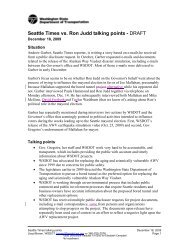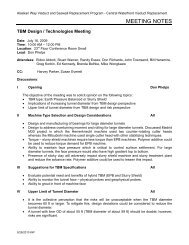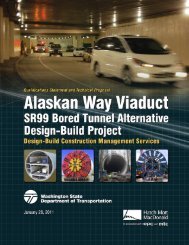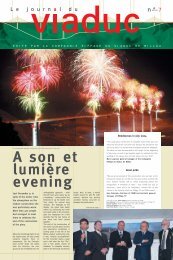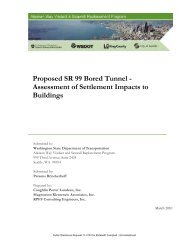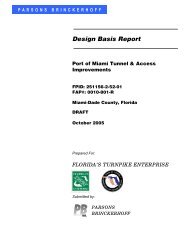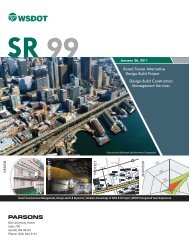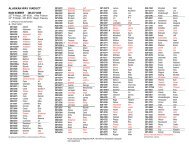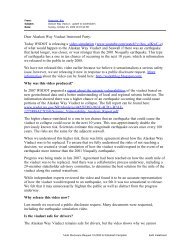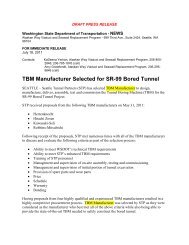080731 6LYG A1 Particular Tunnelling Specification ... - SCATnow
080731 6LYG A1 Particular Tunnelling Specification ... - SCATnow
080731 6LYG A1 Particular Tunnelling Specification ... - SCATnow
Create successful ePaper yourself
Turn your PDF publications into a flip-book with our unique Google optimized e-Paper software.
Lee Tunnel, Contract No. <strong>6LYG</strong>/<strong>A1</strong><br />
PT – <strong>Particular</strong> <strong>Tunnelling</strong> <strong>Specification</strong> - PT200<br />
PT209.5<br />
PT210<br />
PT210.1<br />
PT210.2<br />
PT210.3<br />
PT210.4<br />
PT210.5<br />
PT211<br />
PT211.1<br />
g) An adjustable copy cutter with means of detecting the stroke and the arc<br />
through which it is selected.<br />
The Contractor shall consider in the design of the TBM a means of ensuring a<br />
safe method of work for the personnel carrying out all necessary work on the<br />
cutter head including mechanical aids for the transport of tools and equipment<br />
into the cutter head.<br />
CUTTER HEAD INTERVENTIONS<br />
The Contractor shall submit within 28 days of the award of Contract a Method<br />
Statement detailing the proposed method for cutter head interventions for<br />
planned and unplanned maintenance, head inspections and other events. Should<br />
the use of the TBM compressed air system be considered the Method Statement<br />
shall demonstrate compliance with following compressed air documents:<br />
a) Work in Compressed Air Regulations (1996).<br />
b) Health and Safety Booklet “A Guide to the Work in Compressed Air<br />
Regulations 1996 – Guidance on Regulations (L96).<br />
c) Addendum “A guide to the Work in Compressed Air Regulations 1996 –<br />
Guidance on Oxygen Compression and use of Breathing Mixtures other than<br />
Compressed Natural Air in the Working Chamber” issued by the Health and<br />
Safety Executive.<br />
The Health and Safety Executive have advised the Employer that whilst the<br />
Regulations are not being revised, a new document combining references b) and<br />
c) above, along with a revision of the combined text is in preparation and it is<br />
hoped that this document will be issued by the HSE before the proposed start<br />
date of this Project. It is understood that the HSE document will set out<br />
procedures requirements on the Contractor seeking exemptions from the<br />
Regulations and for the approval by the HSE of the compressed air working<br />
practices which deviate from those required by the regulations. These could<br />
include interventions at pressures greater than the present legal pressure limit of<br />
3.5Bar. With this understanding, it will be the intention of the Employer to hold<br />
discussions with the Contractor to assess and agree what impact these changes<br />
will have on the Contractors proposed methodology for interventions at high<br />
pressures, its impact on the proposed programmes and cost implications. The<br />
Contractor shall, in order to mitigate any potential delays to the Project and to<br />
ensure the cooperation and assistance in obtaining required approval from the<br />
Health and Safety Executive, invite a representative of the HSE to attend any<br />
discussions held on the issue of working in Hyperbaric Conditions. Preliminary<br />
discussions will be held between the Employer and the HSE in advance the<br />
award of Contract to try and secure HSE’s agreement in principle to interventions<br />
at pressure in excess of 3.5Bar.<br />
The Contractor will be responsible for obtaining all Regulatory exemptions and/or<br />
approvals for the proposed methodology and the Project Manager shall be invited<br />
to attend any meetings held with the Health and Safety Executive (with a<br />
minimum of two weeks notice).<br />
The design of airlocks shall conform to BSEN 12110:2002 <strong>Tunnelling</strong> Machines-<br />
Air-Locks Safety Requirements (currently being revised).<br />
The design shall include an effective means of testing for and purging the forward<br />
chamber of any hazardous gases and ventilating the TBM and back up before<br />
entry.<br />
FRONT SHIELD<br />
The Front Shield shall incorporate a pressure bulkhead designed to withstand all<br />
operational pressures.<br />
Thames Water Utilities Limited August 2008<br />
Page 8 of 38




